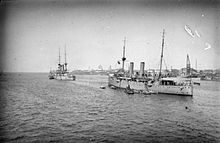William Boyle, 12th Earl of Cork
He served as a junior officer on the China Station during the Boxer Rebellion and went on to serve in the First World War initially as a staff officer during the Dardanelles Campaign and as then commander of the Red Sea Patrol: in that capacity, he led a six-day bombardment of the Turkish held port of Jeddah and worked closely with T. E. Lawrence in support of the Arab Revolt.
Boyle also served in the Second World War, first as head of planning for Operation Catherine, an abortive naval offensive in the Baltic Sea proposed by Winston Churchill which aimed to cut off the flow of iron ore from Sweden.
[6] He joined the Naval Intelligence Division at the Admiralty in January 1909 before becoming Executive Officer in the armoured cruiser HMS Good Hope in the Atlantic Fleet in 1911.
[6] In that capacity he led a six-day bombardment of the Turkish-held port of Jeddah in June 1916 and worked closely with T. E. Lawrence in support of the Arab Revolt.
[15] Promoted to rear admiral on 1 November 1923,[16] he became second-in-command of the 2nd Battle Squadron of the Atlantic Fleet with his flag in the battleship HMS Resolution in May 1924.
[14] After a tour with his squadron on the China Station and promotion to vice admiral on 12 June 1928,[17] he became Commander-in-Chief of the Reserve Fleet with his flag in the light cruiser HMS Constance in December 1928 and President of the Royal Naval College, Greenwich in April 1929.
[18] Promoted to full admiral on 1 November 1932,[19] he became Commander-in-Chief of the Home Fleet flying his flag in the battleship HMS Nelson in March 1933.
"[1] Lord Cork served in the Second World War initially as head of planning for Operation Catherine, a naval offensive in the Baltic Sea proposed by Winston Churchill which aimed to cut off the flow of iron ore from Sweden and isolate Germany from Scandinavian trade.
[14] In April 1940 Cork was given command of a naval force with a mission to retake the strategic port of Narvik in Norway from the Germans: he flew his flag from the cruiser, HMS Aurora.
[14] Cork was in favour of an immediate storming of Narvik using both military and naval forces, but the more cautious army commander, Major General Pierse Joseph Mackesy, had orders not to attempt an opposed landing.

